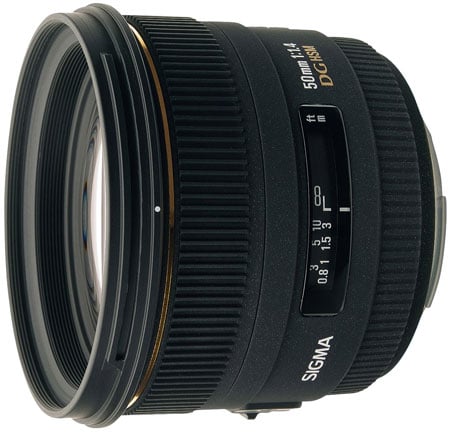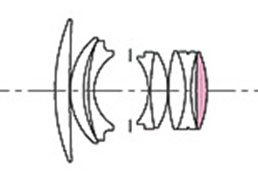Sigma 50mm f1.4 EX review
-
-
Written by Thomas
Intro
The Sigma AF 50mm f/1.4 EX DG HSM is one of Sigma’s trio of f1.4 lenses for full-frame / FX format DSLRs; the other pair offer 35mm and 85mm focal lengths. It’s available for Canon, four-thirds, Nikon, Pentax, and Sony / Konica Minolta camera bodies.
Announced in May 2008 the lens goes head-to-head with the offerings from almost any camera maker: Nikon, Canon, Sony, all have their own version of a 50mm lens with an aperture larger than f1.8. While Sigma normally undercuts the camera manufacturers on price though, the 50mm f1.4 actually costs more than Nikon’s own 50mm f1.4G or Canon’s EF 50mm 1.4 USM. So I’d expect the optical performance of Sigma’s lens to surpass the competition from the big boys.
In my Sigma 50mm f1.4 review I’ll share my findings from testing this lens on a 36MP Nikon D800 body, which is the highest resolving full-frame DSLR-body to date.
 |
Facts from the catalog
As usual I’ll have a look at the technical data first. I’ve rated the features with a [+] (or [++]), when it’s better than average or even state of the art, a [0] if it’s standard or just average, and [-] if there’s a disadvantage.
 | |
Most features are compared to Nikon’s AF-S 50/1.4G.
Size (diam. x length): 85 x 68 mm (3.3 x 2.7 in.). Clearly bulkier than the 50/1.4G at 74 x 54mm but still not too clunky. [0]
Weight: 505 g (17.8 oz). The Nikkor 50/1.4G comes in at 280g. But the Sigma is still well balanced on a full-frame body. [0]
Optics: 8 lenses in 6 groups vs. 8 elements in 7 groups for the 50/1.4G. This is about standard for “normal” lenses. The lens contains one aspheric element while the 50/1.4G had none. [+]
Closest focus distance/max. magnification: 45 cm (1.5 ft.) / 1:7.4. Pretty much standard for “normal” lenses. The 50/1.4G also offers 45cm (1.5 ft.) but at a slightly larger magnification of 1:6.7. [0]
Filter-thread: 77mm = standard of many pro-lenses. [0]
Image stabilization: No, same as any other fixed focal lens below 105mm focal length. [0]
AF: HSM (hyper sonic motor), so it does work on camera-bodies that don’t have their own AF-drive. Manual-focus override by simply turning the focus ring [+]
Covers full frame/FX or smaller = very good [+]
Price: around 420 EUR new (incl. 19% VAT). Almost any manufacturer offers a 50/1.4 at a similar price. [0]
Comes with a nice padded lens pouch (with a belt-loop but no strap), the lens-shade is included, reversible for transport, and the front lens-caps is similar to Nikon’s. Unfortunately the rear lens-cap is of the incredibly dumb designs that can only be screwed on the lens mount in one position. Nikon’s own allows for three positions so you don’t have to fiddle around until you’ve put it on. [0]
Distance information is relayed to the camera, so the Nikon body can do all the advanced exposure-related stuff with this lens. [+]
Aperture ring = no, just like all competitors. [0]
Sealing: no! [-]
The score in the “features-department” is 1[-]/8[0]/4[+]. On paper the lens looks pretty average. Its only fault feature-wise is the lack of any sealing against the elements.
Motivation
:
50mm is not called a “normal” lens (for full-frame bodies) for no good reason. Normal-lenses have a focal length that is close to the diagonal of the sensor (43mm for a full-frame / FX-sensor). These lenses produce a life-like perspective and natural look when the images are also viewed from a distance that is equivalent to the diagonal of the print/monitor. But mind you: 50mm focal length on a full-frame / FX body is not considered long enough for a flattering perspective in head-shot type portraits. For that type of shot you better get a 85mm lens for your FX body. Of course when you mount a 50mm lens on a APS-C body it delivers a much more portrait-friendly 80mm equivalent.
The much coveted f1.4 aperture is 2/3 of a stop brighter than the cheaper f1.8 models and also gives you a larger blur-circle on all out-of-focus subjects. And if you chose to invest only in one f1.4 lens for your work the combination with 50mm focal length might be your best bet to get a good return on your investment.
Alternatives
:
There’s no shortage of 50mm lenses on the market, and many camera and lens companies actually offer a choice of apertures too. The f1.8 versions are definitely worth considering: they are smaller, lighter, cheaper, less obtrusive and often ofter similar – or even superior – image quality than their bigger brothers. The loss of 2/3 of a stop may not be as relevant as the marketing literature is wanting you to believe. But if you absolutely want or need f1.4 then you have the following alternatives:
– From Nikon there are the AF-S 50/1.4G which is similarly priced to the Sigma or the new and much more expensive 58/1.4G (see my Nikon AF-S 58mm f1.4G review). There’s also Nikon’s old AF 50/1.4D still on offer and it’s the cheapest of the bunch. But from what I’ve seen in other reviews the 50/1.4G seems the better choice (see my Nikon AF-S 50mm f/1.4G review).
– Canon offers the EF 50/1.4 USM plus the EF 50/1.2L USM (see Gordon’s Canon EF 50mm f1.2L USM review). Sony has the AF 50/1.4 and the AF 50/1.4 ZA SSM.
– Then there are other alternatives if you can do with manually focusing the lens. But as the dof at f1.4 is pretty shallow make sure that your focusing capabilities are up to that challenge! If so you can choose from the Zeiss ZF.2 Planar T* 50/1.4 at 600 EUR and the Voigtländer SL II Nokton 58/1.4 at 500 EUR. Both lenses perform very well in the image center according to reviews but the Zeiss seems very soft in the FX-corners and the Voigtländer produces a nervous Bokeh. The 800 pound gorilla in this group of MF lenses is the new Zeiss Otus 55/1.4. At a price of 3500 EUR and over 900g weight plus a completely different optical design than other “normal” lenses it sets a new benchmark on optical performance in this group. Read my Zeiss Otus 55/1.4 review.
Focus and build quality
Focus accuracy and repeatability is critical to consistently produce sharp shots, especially with large aperture primes. Repeatability (the accuracy of focus on the same subject after repeated focus-acquisition) of this lens is good with no real outliers but some visible variations over a series of 40 shots. The surprise came when I tried to focus in live-view: There’s no way to make this lens auto-focus in contrast based focusing on a D800, whether in camera live-view or in the movie modes! It just makes a short try and then stops. I switched to a D300 and it did AF in live-view albeit with a lot of stutter and some over-shooting. This may be just a problem with my copy of the lens. But before you get one make sure to try this out if Live View Af is important to you. When using normal phase-detect AF through the DSLR viewfinder though the lens focuses quickly in around 0.5 sec from infinity to 60 cm, which is a very good value (the Nikon 50/1.4G does this in 0.8 sec). On some targets there is a short “stutter” before final focus is acquired.
The focus ring has no slack/play between its movement and the focus-action and a throw of around 90 degrees, which is very short for accurate focus wide open (the Nikon 50/1.4 turns 190 degrees). The focus ring is easy to grip but a little small for my liking and moves a bit stiff. The fast AF emits some noise especially when stopping which it often does with an audible “clack”.
The lens has a metal lens-mount and nine rounded aperture blades but no weather sealing.
Now it’s time to check out some results in my Sigma 50mm f1.4 quality and Sigma 50mm f1.4 sample images pages, or if you’d like to skip to chase, head straight for my verdict!
 All-in-all it is a good f1.4 lens which you can well use at the largest aperture although you have to accept at f1.4 the corners are soft. But that may not be a bad thing depending on your type of photography. And although the lens does not do contrast-based AF in live-view or movie-mode on my D800 I'd say that manual focus in both modes often is a viable alternative. The functionality of contrast-based AF may also be better on other camera-bodies. And normal phase-detect AF through my DSLR viewfinder was fast and reliable. So I'd still award the Sigma 50/1.4 a Recommended rating.
All-in-all it is a good f1.4 lens which you can well use at the largest aperture although you have to accept at f1.4 the corners are soft. But that may not be a bad thing depending on your type of photography. And although the lens does not do contrast-based AF in live-view or movie-mode on my D800 I'd say that manual focus in both modes often is a viable alternative. The functionality of contrast-based AF may also be better on other camera-bodies. And normal phase-detect AF through my DSLR viewfinder was fast and reliable. So I'd still award the Sigma 50/1.4 a Recommended rating.


